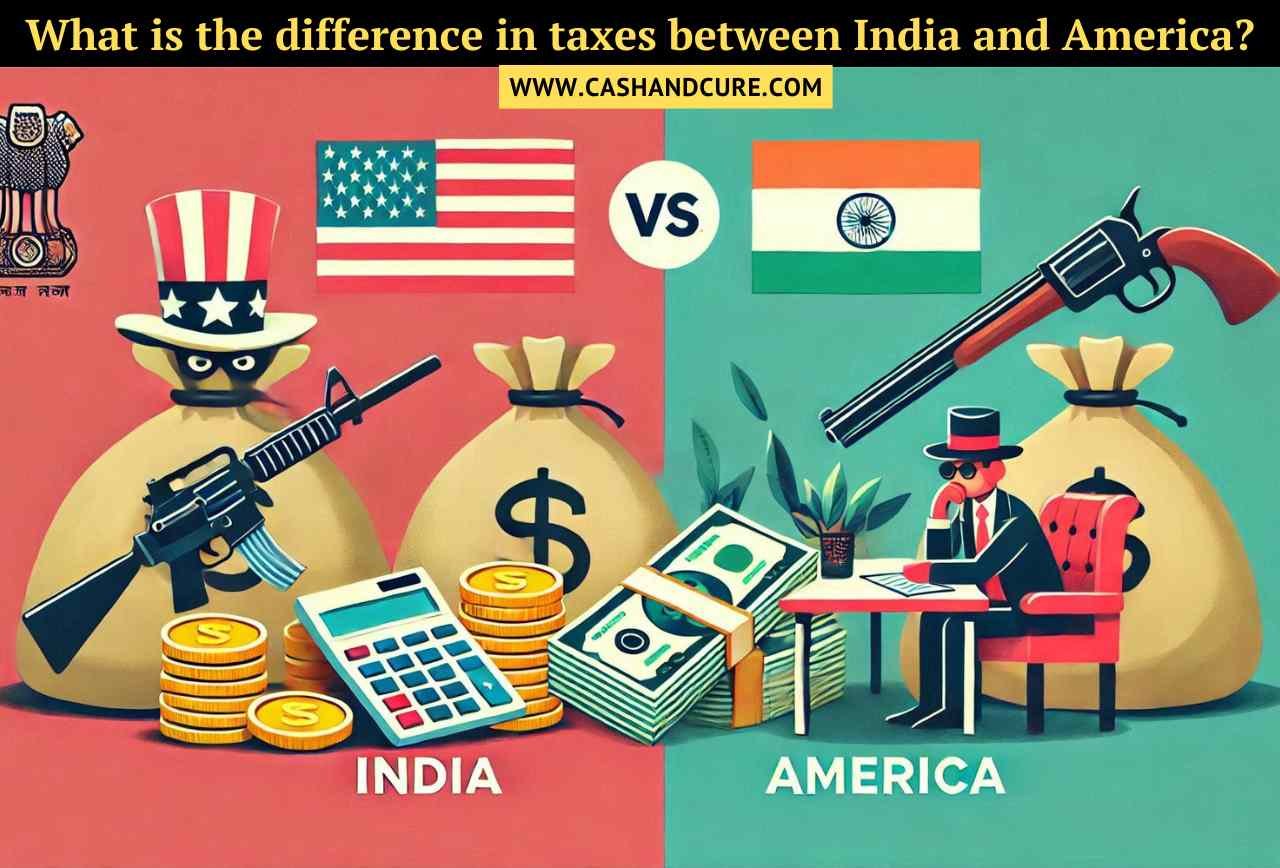What is the difference in taxes between India and America?Understanding the differences in tax systems between India and America is crucial for individuals and businesses operating in both countries. This blog post will explore the key differences in taxes between India and America, delve into the emotional aspects of dealing with taxes, and provide insights, experiences, and actionable advice. We will also include some frequently asked questions (FAQs) to enhance your understanding.
What is the difference in taxes between India and America?

Both India and America have complex tax systems that are designed to generate revenue for the government and provide public services. However, there are significant differences in how these systems are structured and implemented.
Tax Structure in India
India follows a progressive tax system, where the tax rate increases as the taxpayer’s income increases. The primary taxes in India include:
- Income Tax: Levied on individual and corporate income. The tax rates vary based on income slabs and the age of the taxpayer.
- Goods and Services Tax (GST): A comprehensive indirect tax on the manufacture, sale, and consumption of goods and services. It replaced multiple indirect taxes like VAT, service tax, and excise duty.
- Corporate Tax: Levied on the profits of companies. The rates vary based on the type of company and its turnover.
- Capital Gains Tax: Levied on the profit from the sale of assets like property, stocks, and bonds.
- Property Tax: Levied by local municipalities on real estate properties.
Tax Structure in America
The United States also follows a progressive tax system, but it has a more diverse set of tax categories. The primary taxes in America include:
- Federal Income Tax: Levied by the federal government on individual and corporate income. The tax rates vary based on income brackets and filing status (e.g., single, married filing jointly).
- State Income Tax: Levied by individual states on income. The rates and rules vary significantly from state to state.
- Sales Tax: Levied by states and local governments on the sale of goods and services. The rates vary by location.
- Corporate Tax: Levied on the profits of companies. The federal corporate tax rate is fixed, but states may impose additional corporate taxes.
- Capital Gains Tax: Levied on the profit from the sale of assets like property, stocks, and bonds.
- Property Tax: Levied by local governments on real estate properties.

Key Differences in Taxes Between India and America
1. Income Tax
In India, the income tax system is divided into different slabs based on the taxpayer’s age and income. As an illustration, individuals below the age of 60 are taxed at different rates than older people. The tax rates range from 5% to 30%.
In contrast, the U.S. federal income tax system is based on income brackets and filing status. The tax rates range from 10% to 37%. Additionally, taxpayers may be subject to state income taxes, which vary by state.
2. Corporate Tax
India’s corporate tax rates vary based on the type of company and its turnover. For example, domestic companies with a turnover of up to INR 400 crore are taxed at 25%, while other companies are taxed at 30%.
In the U.S., the federal corporate tax rate is a flat 21%. However, states may impose additional corporate taxes, leading to variations in the overall tax burden.
3. Goods and Services Tax (GST) vs. Sales Tax
India’s GST is a comprehensive indirect tax that replaced multiple indirect taxes. It is levied at different rates depending on the type of goods and services.
In the U.S., sales tax is levied by states and local governments. The rates and rules vary significantly by location, and there is no federal sales tax.
4. Capital Gains Tax
Both India and the U.S. levy capital gains tax on the profit from the sale of assets. In India, the tax rates depend on the holding period of the asset (short-term vs. long-term) and the type of asset.

Dealing with Taxes
Dealing with taxes can evoke a range of emotions, from anxiety and frustration to relief and satisfaction. Here are some common emotional aspects associated with taxes:
- Anxiety: The complexity of tax laws and the fear of making mistakes can cause anxiety for many taxpayers.
- Frustration: The time and effort required to file taxes and comply with regulations can be frustrating.
- Relief: Successfully filing taxes and meeting obligations can bring a sense of relief.
- Satisfaction: Receiving a tax refund or successfully navigating tax laws can provide a sense of accomplishment.
Insights and Experiences of Tax Structure
Navigating the tax systems in India and America requires a good understanding of the rules and regulations. Here are some insights and experiences from individuals who have dealt with taxes in both countries:
- Stay Informed: Keeping up with changes in tax laws and regulations is crucial. Both India and the U.S. frequently update their tax codes, and staying informed can help you avoid penalties and maximize deductions.
- Seek Professional Help: Consulting with a tax professional can provide valuable guidance and ensure that you comply with all tax requirements. This is especially important for individuals with complex financial situations.
- Organize Your Documents: Keeping your financial documents organized throughout the year can make the tax filing process smoother and less stressful.
- Plan Ahead: Tax planning is essential for minimizing your tax liability. Consider strategies like tax-advantaged investments and retirement accounts to reduce your taxable income.
Actionable Advice for Taxpayers
- Understand Your Tax Obligations: Familiarize yourself with the tax laws and regulations in your country. This includes knowing the tax rates, filing deadlines, and required forms.
- Keep Accurate Records: Maintain detailed records of your income, expenses, and deductions. This will help you accurately file your taxes and provide documentation in case of an audit.
- Use Tax Software: Tax software can simplify the filing process and help you identify deductions and credits you may be eligible for.
- Review Your Tax Return: Before submitting your tax return, review it carefully to ensure accuracy. Double-check all calculations and make sure you have included all necessary information.
- Stay Updated: Tax laws can change frequently. Stay updated on any changes that may affect your tax situation and adjust your tax planning strategies accordingly.
Differences in Taxes Between India and America
Here’s a detailed comparison of the tax systems in India and America, presented in a column format for clarity:
| Aspect | India | America |
|---|---|---|
| Income Tax Structure | Progressive tax system with different slabs based on age and income. | Progressive tax system with brackets based on income and filing status. |
| Income Tax Rates | Ranges from 5% to 30% based on income slabs. | Ranges from 10% to 37% based on income brackets. |
| Corporate Tax | Varies based on company type and turnover (e.g., 25% for domestic companies with turnover up to INR 400 crore). | Flat federal rate of 21%, with additional state taxes. |
| Goods and Services Tax (GST) | Comprehensive indirect tax replacing multiple taxes, with rates varying by goods and services. | No federal sales tax; states and local governments levy sales tax with varying rates. |
| Capital Gains Tax | Rates depend on holding period (short-term vs. long-term) and asset type. | Rates depend on holding period and income bracket. |
| Property Tax | Levied by local municipalities on real estate properties. | Levied by local governments on real estate properties. |
| State Income Tax | Not applicable. | Levied by individual states, with rates and rules varying by state. |
| Tax Forms | Includes Form 16 and ITR-1 to ITR-7 for different types of taxpayers. | Includes various forms like 1040, 1040A, and 1040EZ for different filing statuses. |
| Double Taxation Avoidance | India has Double Tax Avoidance Agreements (DTAAs) with various countries, including the USA. | The USA also has DTAAs with various countries, including India. |
| Tax Filing Deadline | Typically July 31st for individuals. | Typically April 15th for individuals. |
| Tax Deductions and Credits | Various deductions under sections like 80C, 80D, etc. | Various deductions and credits like the Earned Income Tax Credit (EITC), Child Tax Credit, etc. |

Key Differences in Taxes Between India and America
| Aspect | India | America |
|---|---|---|
| Tax Type | Goods and Services Tax (GST) | State and local sales taxes |
| Tax Rate | 18% uniform across the country | Varies by state and locality (e.g., 8% in some states) |
| Tax Calculation | GST is added to the base price of the smartphone | Sales tax is added to the base price of the smartphone |
| Uniformity | Uniform GST rate across all states | Varies significantly by state and locality |
| Example Total Price | Rs.17,700 for a Rs.15,000 smartphone | $540 for a $500 smartphone |
Frequently Asked Questions (FAQs)
The primary differences include the structure of income tax, corporate tax rates, and the types of indirect taxes (GST in India vs. sales tax in the U.S.). Additionally, the U.S. has state income taxes, while India does not
India’s income tax system is based on age and income slabs, while the U.S. system is based on income brackets and filing status.
India’s corporate tax rates vary based on the type of company and its turnover, while the U.S. has a flat federal corporate tax rate of 21%, with additional state taxes.
This question seems unrelated to the topic of taxes. However, if you are looking for books on tax systems, you can find them at major bookstores and online retailers like Amazon and Barnes & Noble.
Conclusion: What is the difference in taxes between India and America?
Understanding the differences in tax systems between India and America is essential for individuals and businesses operating in both countries. By familiarizing yourself with the key differences, staying informed about changes in tax laws, and seeking professional guidance, you can navigate the complexities of taxes with confidence. Whether you are dealing with income tax, corporate tax, or indirect taxes, being proactive and organized can help you minimize your tax liability and avoid potential pitfalls.


Leave a Reply
You must be logged in to post a comment.